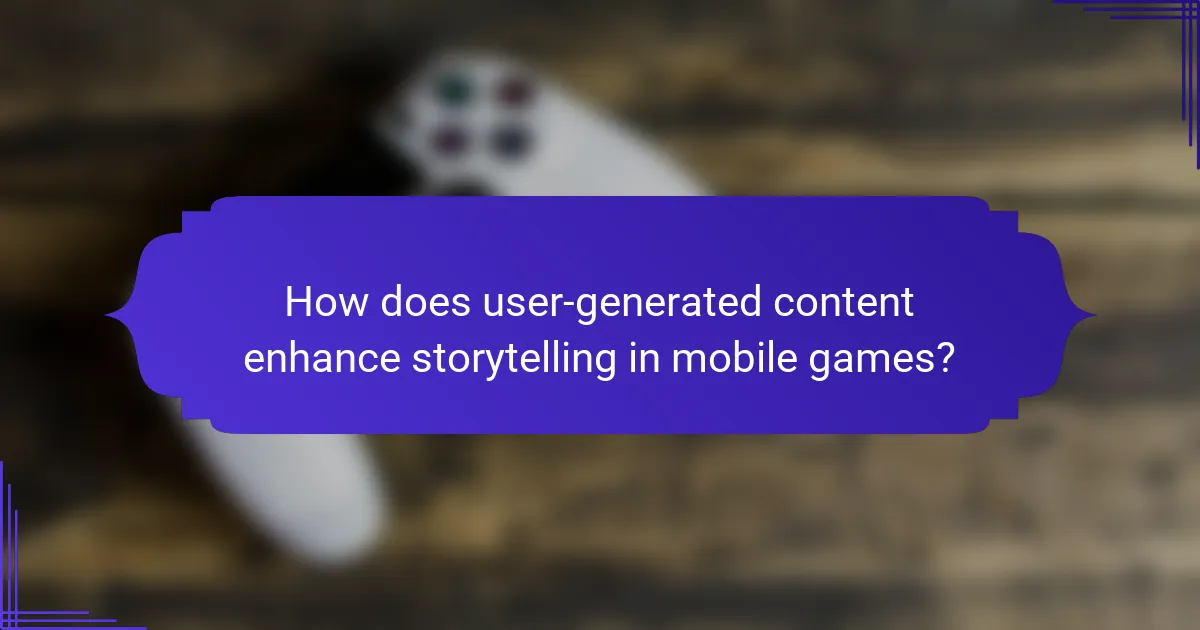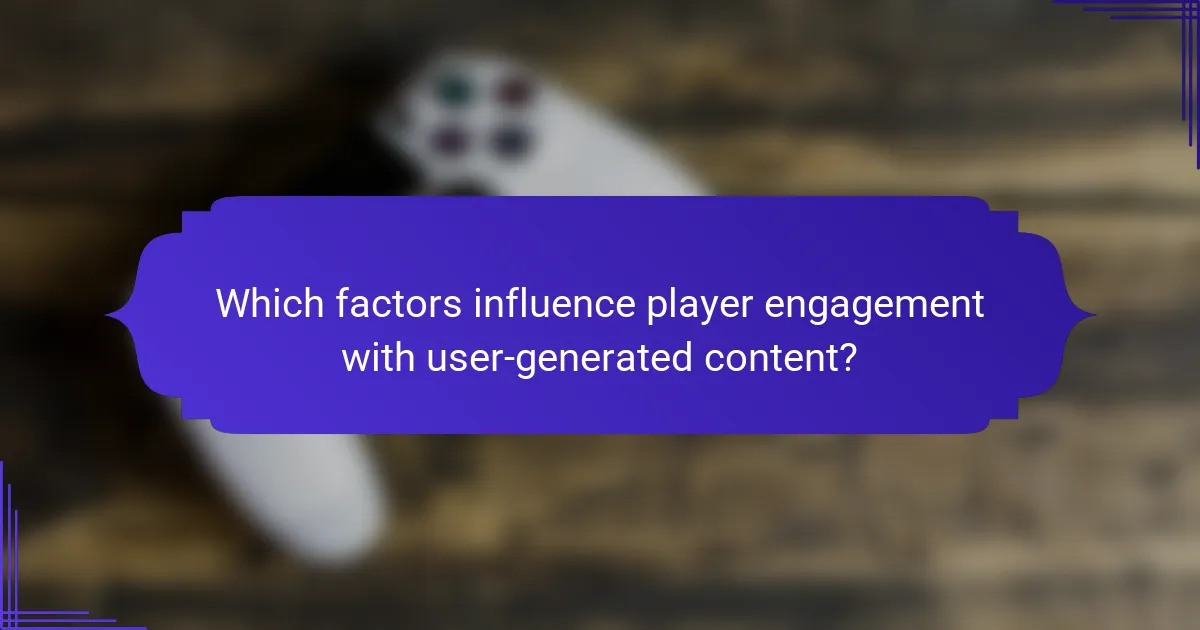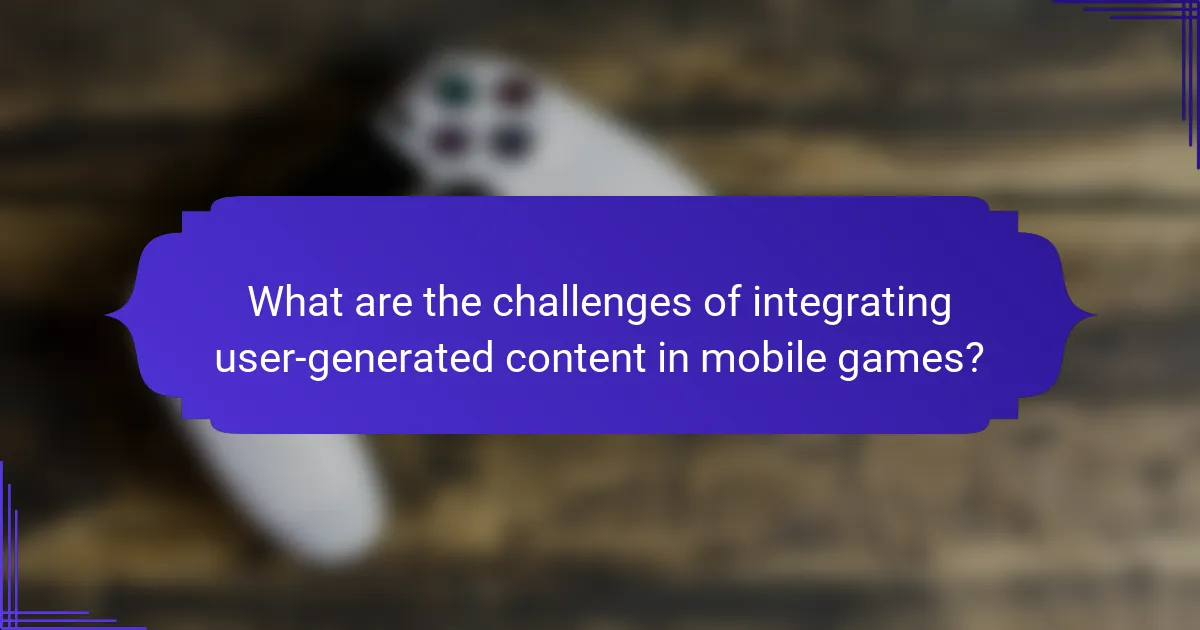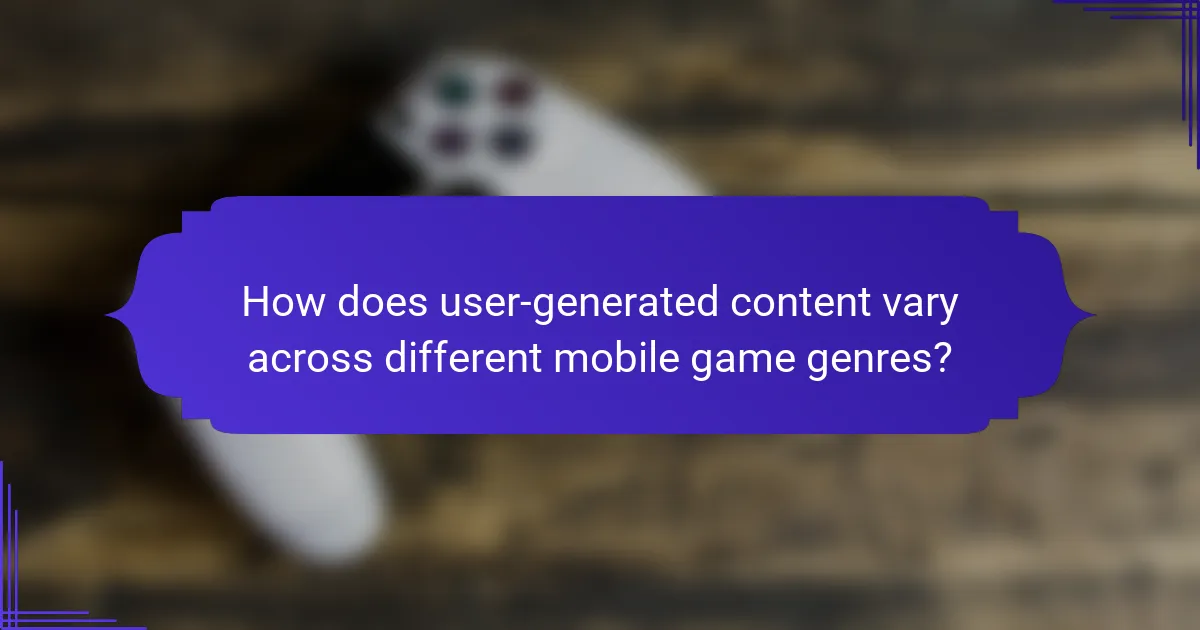User-generated content in mobile games enhances storytelling and player engagement by fostering creativity and community interaction. It influences player involvement through social collaboration and feedback mechanisms. Various game genres showcase unique impacts on narrative and engagement. Notable examples like “Dreams,” “Fortnite,” and “Roblox” illustrate the effectiveness of user-generated content in creating immersive experiences.

How does user-generated content enhance storytelling in mobile games?
User-generated content significantly enhances storytelling in mobile games by fostering player engagement and creativity. Players contribute their narratives, characters, and quests, enriching the game world. This involvement creates a community-driven experience, allowing for diverse storytelling perspectives. As a result, games become more immersive and personalised, increasing player retention and satisfaction. User-generated content also encourages social interaction, as players share their creations, leading to collaborative storytelling and a vibrant gaming ecosystem.
What are the different forms of user-generated content in mobile games?
User-generated content in mobile games takes various forms, enhancing storytelling and player engagement. Common types include user-created levels, character designs, game mods, in-game events, and community forums. These contributions foster creativity, encourage collaboration, and strengthen community ties. As a result, players feel more invested in the game experience, leading to increased retention and satisfaction.
How do players contribute to narrative development through user-generated content?
Players contribute to narrative development through user-generated content by creating immersive stories and characters. This engagement enhances the gaming experience and fosters community interaction. User-generated narratives often reflect personal experiences, allowing players to shape the game world. As a result, mobile games become dynamic platforms where storytelling evolves based on player input. This collaborative storytelling not only increases player investment but also enriches the game’s overall narrative depth.
What impact does user-generated storytelling have on player immersion?
User-generated storytelling significantly enhances player immersion by fostering personal connections to the game. Players feel more invested when they contribute narratives, leading to deeper engagement. This participatory approach allows for unique experiences, as user-generated content can reflect individual creativity and perspectives. As a result, games become more dynamic and relatable, enriching the overall gaming experience.

Which factors influence player engagement with user-generated content?
Player engagement with user-generated content is influenced by factors such as creativity, social interaction, and feedback mechanisms. High creativity in user-generated content attracts players, enhancing their emotional investment. Social interaction fosters community, encouraging collaboration and competition among players. Feedback mechanisms, including ratings and comments, provide validation, motivating users to create and share more content. These elements collectively enhance the storytelling experience and sustain player interest in mobile games.
How does the quality of user-generated content affect player retention?
High-quality user-generated content significantly enhances player retention in mobile games. Engaging narratives and interactive elements foster a sense of community and belonging. Players are more likely to return when they feel their contributions are valued and impactful. This creates a cycle where user-generated content not only attracts new players but also keeps existing ones engaged.
What role does community interaction play in enhancing engagement?
Community interaction significantly enhances engagement in mobile games by fostering a sense of belonging. Players who contribute user-generated content often feel more invested in the game’s narrative and dynamics. This interaction leads to increased player retention and satisfaction, as they see their contributions reflected in the game. Additionally, community-driven storytelling can introduce unique perspectives, enriching the overall gaming experience. Engaging with fellow players through forums or in-game events further strengthens these connections, creating a vibrant ecosystem that encourages ongoing participation.
How do mobile game platforms facilitate user-generated content sharing?
Mobile game platforms enhance user-generated content sharing by providing tools for creation, collaboration, and distribution. These platforms often integrate social features that allow players to share their creations easily.
For instance, many mobile games offer in-game editors that enable users to design levels or characters. This encourages creativity and fosters a sense of community. As a result, user-generated content can significantly impact storytelling by introducing diverse narratives shaped by player input.
Additionally, sharing features such as direct links, social media integration, and in-game showcases amplify engagement. Players can showcase their creations to a broader audience, leading to increased interaction and feedback. This dynamic exchange enriches the gaming experience and cultivates a vibrant ecosystem of shared content.

What are the challenges of integrating user-generated content in mobile games?
Integrating user-generated content in mobile games presents several challenges, including moderation, quality control, and technical limitations. Moderation is crucial to ensure content aligns with community standards and does not harm the game’s reputation. Quality control is necessary to maintain a high standard of player experience, as poorly created content can detract from engagement. Technical limitations may arise from varying device capabilities, making it difficult to implement user-generated features consistently across platforms.
How do developers manage content moderation effectively?
Developers manage content moderation effectively by implementing automated systems, community guidelines, and user reporting tools. Automated systems analyze user-generated content for inappropriate material, ensuring swift action. Community guidelines establish clear expectations, fostering a positive environment. User reporting tools empower players to flag issues, enhancing engagement and accountability. This approach balances creativity and safety, promoting storytelling without compromising user experience.
What are the legal implications of user-generated content in mobile games?
User-generated content in mobile games can lead to legal challenges regarding copyright and liability. Developers must ensure that user contributions do not infringe on intellectual property rights. Additionally, they may face liability for harmful content created by users. Clear terms of service can mitigate risks by outlining ownership and responsibilities. Engaging users while protecting legal interests is crucial for sustainable game development.

How does user-generated content vary across different mobile game genres?
User-generated content varies significantly across mobile game genres, influencing storytelling and engagement. In role-playing games, players create narratives, enhancing immersion. In puzzle games, user-generated levels foster creativity and replayability. Sandbox games allow extensive customisation, promoting community collaboration. Competitive genres see users generating strategies and content that elevate engagement through shared experiences. Each genre’s unique attributes shape how user-generated content impacts player interaction and overall enjoyment.
Which genres benefit the most from user-generated content?
User-generated content significantly benefits genres like role-playing games, social simulation games, and multiplayer online games. These genres thrive on player creativity, enhancing storytelling and engagement.
Role-playing games often incorporate user narratives, allowing players to contribute to the game world. Social simulation games utilise user-generated content for customisation, fostering community interaction. Multiplayer online games leverage user contributions to create dynamic environments and shared experiences.
In summary, genres that emphasise community interaction and creativity gain the most from user-generated content, driving player engagement and enriching storytelling.
How do genre-specific mechanics influence user contributions?
Genre-specific mechanics significantly enhance user contributions by shaping gameplay dynamics and narrative engagement. These mechanics encourage players to create content that aligns with the game’s themes and objectives. For instance, role-playing games often feature character customisation, which invites users to share their unique character stories, enriching the overall narrative.
Additionally, competitive genres like battle arenas prompt users to develop strategies and tactics, fostering a community of shared knowledge. This interaction not only deepens engagement but also creates a feedback loop where user-generated content influences game updates and expansions. Ultimately, genre-specific mechanics cultivate a vibrant ecosystem of creativity and collaboration among players.

What unique case studies highlight the impact of user-generated content in mobile games?
User-generated content significantly enhances storytelling and engagement in mobile games. Case studies illustrate this impact through community-driven narratives and player involvement.
One notable example is “Dreams” by Media Molecule, where players create and share their own games and stories. This fosters a collaborative environment, leading to diverse content and high player engagement.
Another example is “Fortnite,” which incorporates user-generated content through player-created maps and game modes. This feature keeps the gameplay fresh and encourages players to participate actively in the game’s evolution.
In “Roblox,” user-generated content is central to its success, allowing players to design their own games. This platform empowers creativity and builds a strong community, resulting in sustained user engagement and loyalty.
What lessons can be learned from successful user-generated content campaigns?
Successful user-generated content campaigns enhance storytelling and engagement in mobile games by fostering community involvement. They encourage players to share experiences, leading to authentic narratives that resonate with audiences. For example, integrating player-created content can deepen emotional connections and enhance gameplay immersion. Additionally, campaigns that highlight user contributions often see increased retention rates and social sharing, amplifying brand visibility. Engaging users through contests or challenges can drive participation and creativity, resulting in a vibrant content ecosystem that benefits both players and developers.
How do cultural differences affect user-generated content in mobile games?
Cultural differences significantly shape user-generated content in mobile games by influencing storytelling and engagement. Diverse cultural backgrounds lead to varied interpretations of narratives, character development, and gameplay mechanics.
For example, players from collectivist cultures may prioritise community-driven narratives, while individualistic cultures might focus on personal achievements. This distinction affects how content is created and shared, impacting player engagement levels.
Moreover, cultural symbols and references can resonate differently across regions. Games that incorporate local cultural elements tend to foster deeper connections with players, enhancing the overall gaming experience.
In summary, understanding cultural differences is crucial for developers to create inclusive content that resonates with a global audience, ultimately driving user engagement and satisfaction.

What best practices should developers follow for leveraging user-generated content?
Developers should prioritise authenticity, engagement, and moderation when leveraging user-generated content. Authentic content resonates with players, enhancing storytelling and immersion. Encouraging community interaction fosters deeper engagement, making players feel invested. Effective moderation ensures a safe environment, preserving the game’s integrity and community standards.
How can developers encourage positive contributions from the player community?
Developers can encourage positive contributions from the player community by fostering an inclusive environment and providing clear guidelines. Engaging players through feedback and recognition enhances their sense of ownership. Incentives like in-game rewards for quality contributions can motivate creativity. Regular updates showcasing user-generated content can also strengthen community ties.
What strategies can enhance the visibility of user-generated content in games?
Encouraging user-generated content visibility in games involves leveraging community engagement and effective promotion strategies. Foster a strong community by implementing forums and social media channels where players can share their creations.
Incorporate in-game features that showcase user content, such as galleries or contests, enhancing user engagement and motivation. Utilise influencers and streamers to highlight user-generated content, amplifying reach and visibility.
Encourage collaboration among players by introducing co-creation tools, allowing users to build upon each other’s work. Finally, provide incentives, such as rewards or recognition, to stimulate ongoing participation and sharing within the community.
What common mistakes should developers avoid when implementing user-generated content?
Developers should avoid several common mistakes when implementing user-generated content in mobile games. Failing to moderate content can lead to inappropriate material affecting player experience. Ignoring player feedback may result in disengagement, while not integrating user-generated content into the game’s narrative can diminish its impact. Additionally, neglecting to provide clear guidelines for contributions can lead to confusion and low-quality submissions. Lastly, overlooking the importance of community management can hinder the growth and engagement of the player base.
